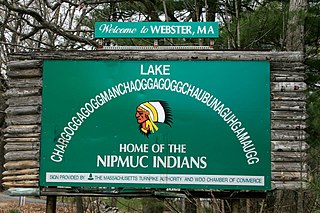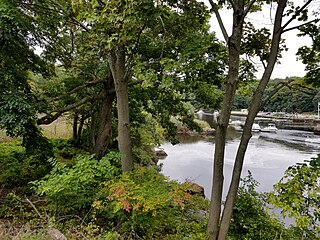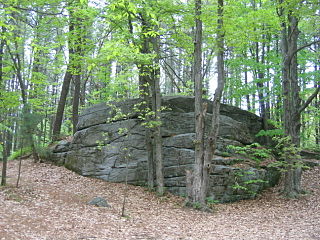 W
WAquinnah is a town located on the western-end of Martha's Vineyard island, Massachusetts. From 1870 to 1997, the town was incorporated as Gay Head. In the 2010 U.S. census, the population was 311. Aquinnah is known for its beautiful clay cliffs and natural serenity, as well as its historical importance to the native Wampanoag people. In 1965, Gay Head Cliffs were designated as a National Natural Landmark by the National Park Service.
 W
WHendrick Aupaumut (1757-1830) was a Mohican historian and diplomat, born among the Stockbridge Indians in Massachusetts, who were originally from the Hudson River Valley. He was educated by Moravians and converted to Protestantism. Aupaumut was a soldier at the time of the American Revolutionary War, in which he served on the American side as a captain of Mohican warriors.
 W
WIn archeological literature, the name Boylston Street Fishweir refers to ancient fishing structures first discovered in 1913, buried 29 to 40 feet below Boylston Street in Boston, Massachusetts. Reports written in 1942 and 1949 describe what was thought to be remains of one large fishweir, 2,500 years old, made of up to 65,000 wooden stakes distributed over an estimated 2 hectares of the former mud flat and marshland in what is now the Back Bay section of Boston. A different interpretation of these findings is offered by new evidence and contemporary archeological research techniques.
 W
WZara Cisco Brough (1919–1988), often spelled as Zara Ciscoe Brough, commonly referred to as Princess White Flower, served as the Chief of the Nipmuc Native Indian Tribe for 25 years from 1962 until 1987. She is best known for her work to preserve Nipmuc heritage, especially her letter of intention to petition for federal recognition of the Nipmuc as a legally distinct Native American people, which resulted in the Nipmuc being placed on "active consideration" for the status of Federally recognized tribe by 11 July 1995.
 W
WThe Webster/Dudley Band of the Chaubunagungamaug Nipmuck Indians, also known as the Chaubunagungamaug, Chaubunagungamaug Nipmuck, Pegan or Dudley Indians, are a Native American tribe indigenous to the U.S. states of Massachusetts and Connecticut in the region of New England. They are one of three tribes with state recognition in Massachusetts as a tribe of Nipmuck Indians, including the Hassanamisco Nipmuc and the Natick Massachusett, although the latter are mainly descended from the Massachusett people.
 W
WCaleb Cheeshahteaumuck was the first Native American to graduate from Harvard University.
 W
WChickatawbut was the sachem, or leader, of a large group of indigenous people of what is now eastern Massachusetts, United States, known as the Massachusett tribe, during the initial period of English settlement in the region in the early seventeenth century. In 1630 Chickatawbut deeded the land that is now Boston to the Puritans.
 W
WCutshamekin was a Native American leader, who was a sachem of the Massachusett tribe based along the Neponset River and Great Blue Hill in what is now Dorchester, Massachusetts and Milton, Massachusetts before becoming one of the first leaders of the praying Indian town of Natick, Massachusetts. He is the possible namesake of Jamaica Plain.
 W
WDaniel Takawambait was likely the first ordained Native American Christian pastor in North America, and served the church in the praying town of Natick, Massachusetts from 1683 to 1716. Takawambait also advocated for indigenous land rights in colonial Massachusetts, and authored at least one publication.
 W
WEpenow was a Nauset from Martha's Vineyard, Massachusetts who became an early symbol of resistance to English explorers and slavers in the early 17th century. Captured by an English expedition, he was taken to England, but was returned on a subsequent voyage to serve as interpreter. He then made his escape, and warned others to be wary of the English.
 W
WGray Lock, was a Western Abenaki warrior chieftain of Woronoco/Pocumtuck ancestry who came to lead the Missisquoi Abenaki band, and whose direct descendants have led the Missisquoi Abenaki until the current day. Born around 1670 near what is now Westfield, Massachusetts, he eventually became the most illustrious and prominent leader to arise among the dwindling Waranoak, once the predominant original inhabitants of the central Connecticut River Valley in today's New England region.
 W
WHail to the Sunrise is the name of a monument in Charlemont, Massachusetts. The monument features a prominent statue of a Mohawk Indian and a reflecting pool. Completed in 1932, it is a major feature of Mohawk Park, a roadside park located beside Massachusetts Route 2, the Mohawk Trail.
 W
WThe Indian College was an institution established in the 1640s in order to educate Native American students at Harvard College in the town of Cambridge, in the Massachusetts Bay Colony. The College's building in Harvard Yard was completed in 1656 and it housed a printing press used to publish the first Bible translated into a Native American language: the Eliot Indian Bible. The Indian College was supported financially by the Society for the Propagation of the Gospel in New England, a Christian missionary charity based in London.
 W
WDeacon Simon Johnson was a political and religious leader in Gay Head, Massachusetts throughout the mid-nineteenth century. He also managed the Massachusetts Humane Society Gay Head Lifesaving Station, where he recruited volunteer rescue mission volunteers from a pool of either fishermen or whalers.
 W
WKing Philip's War was an armed conflict in 1675–1678 between indigenous inhabitants of New England and New England colonists and their indigenous allies. The war is named for Metacom, the Wampanoag chief who adopted the name Philip because of the friendly relations between his father Massasoit and the Mayflower Pilgrims. The war continued in the most northern reaches of New England until the signing of the Treaty of Casco Bay in April 1678.
 W
WKing Phillip's Cave is a cave in Norton, Massachusetts near Lake Winnecunnett. It may be accessed from Stone Run Drive off Plain Street near Bay Road and sits on a 7-acre (28,000 m2) parcel of land owned by the Land Preservation Society, an independent non-profit conservation organization chartered in 1970 by the State of Massachusetts.
 W
WThe Massachusett are a Native American people and ethnic group in the United States Commonwealth of Massachusetts, mostly inhabiting their traditional homeland which covers much of present-day Greater Boston. The people take their name from the Algonquian, which is a tribal term meaning “At the Great Hill” - referring to the Blue Hills overlooking Boston Harbor from the south - which was a ceremonial and sacred area for the people of the region.
 W
WThe Massachusett language is an Algonquian language of the Algic language family, formerly spoken by several peoples of eastern coastal and southeastern Massachusetts. In its revived form, it is spoken in four communities of Wampanoag people. The language is also known as Natick or Wôpanâak (Wampanoag), and historically as Pokanoket, Indian or Nonantum.
 W
WMassachusett Pidgin English was an English-based contact language that had developed in early seventeenth century New England and Long Island as a medium of communication between the Native speakers of Algonquian languages and the English settlers that began to settle the coastal areas in 1620s. The use of Massachusett Pidgin English co-existed in Massachusett-speaking communities with their original dialects as well as Massachusett Pidgin, another contact language that was Massachusett-based. Unlike Massachusett Pidgin, which was confused with the Massachusett language by the English colonists, attestations of Massachusett Pidgin English are quite numerous. As few of the colonists were able to or willing to master either Massachusett or its Pidgin variety, those that traded and lived directly next to Indian villages communicated in Massachusett Pidgin English. The use of Massachusett Pidgin English supplanted the use of Massachusett Pidgin and likely even overtook the native language in community. In a process likely to decreolization, the speakers of Massachusett Pidgin English began to adjust their language to the English of their neighbors, and since the nineteenth century, all the descendants of the Massachusett-speaking peoples have been monolingual English speakers.
 W
WMassasoit Sachem or Ousamequin was the sachem or leader of the Wampanoag confederacy. Massasoit means Great Sachem.
 W
WMetacom, also known as Pometacom, Metacomet, and by his adopted English name King Philip, was sachem to the Wampanoag people and the second son of the sachem Massasoit. Metacom became sachem in 1662 when his brother Wamsutta died shortly after the death of their father. Wamsutta's widow Weetamoo, squa sachem of the Pocasset, was Metacom's ally and friend for the rest of his life. Metacom married Weetamoo's younger sister Wootonekanuske. It is unclear how many children they had or what happened to them. Wootonekanuske and one of their sons were sold to slavery in the West Indies following the defeat of the Native Americans in what became known as King Philip's War.
 W
WThe Patuxet were a Native American band of the Wampanoag tribal confederation. They lived primarily in and around modern-day Plymouth, Massachusetts. The Patuxet have been extinct since 1622.
 W
WThe Pennacook, also known by the names Penacook and Pennacock, were a North American people of the Wabanaki Confederacy who primarily inhabited the Merrimack River valley of present-day New Hampshire and Massachusetts, as well as portions of southern Maine. They are also sometimes called the Pawtucket people or the Merrimack people.
 W
WPraying towns were developed by the Puritans of New England from 1646 to 1675 in an effort to convert the local Native American tribes to Christianity. The Natives who moved into these towns were known as Praying Indians. Before 1674 the villages were the most ambitious experiment in converting Native Americans to Christianity in the English colonies. John Eliot learned Massachusett and first preached to the Natives in their own language in 1646 at Nonantum, meaning "place of rejoicing." Newton developed here. This sermon led to a friendship with Waban, who became the first Native American in Massachusetts to convert to Christianity.
 W
WJames Printer, also known as Wowaus, (1640–1709) was a Native American from the Nipmuc tribe who studied and worked as a printer in Cambridge, Massachusetts. He was one of the most famous early Nipmuc writers. Printer was the first Native American printer's devil in America as well as one of John Eliot's most accomplished interpreters who assisted in the creation of the Eliot Indian Bible.
 W
WProfile Rock was a 50-foot high granite rock formation located in Freetown, Massachusetts just outside Assonet village and near the Freetown State Forest. Local Wampanoags believe it to be the image of Chief Massasoit. The Wampanoags occupied the region of Rhode Island and Massachusetts bounded by Narragansett Bay to the west and the Atlantic Ocean to the east, and Chief Massasoit was a close friend to the early Pilgrim settlers.
 W
WQuashaamit was a bilingual Praying Indian sachem or sub-sachem, and teaching minister, possibly affiliated with the Nipmuc, (Massachusett) and Wampanoag tribes. Quashaamit worked closely with Massasoit, Metacomet, Wamsutta, and Wampatuck and deeded large tracts of land to early settlers in what is now Massachusetts and Rhode Island.
 W
WJohn Wannuaucon Quinney was a Mahican diplomat, and was nicknamed "The Dish".
 W
WRedemption Rock is a colonial-era historic site in Princeton, Massachusetts. In 1676, during King Philip's War, the release of Mary Rowlandson from her Native American captors was negotiated atop a granite ledge. The .25-acre (0.10 ha) parcel upon which the rock stands was acquired by the land conservation non-profit organization The Trustees of Reservations in 1953, and is open to the public.
 W
WThe Rock House Reservation is a 196-acre (79 ha) open space preserve located in West Brookfield, Massachusetts. The property, acquired in 1993 by the land conservation non-profit organization The Trustees of Reservations, is named for a natural rock shelter once used as a winter camp by Native Americans. Its location near two, long Native American footpaths suggests that it may also have been a trail camp and meeting place.
 W
WThe Siege of Springfield was a conflict around the colonial settlement of Springfield, Massachusetts during King Philip's War. Springfield was the second and final New England settlement burned to the ground during the war; the first was Providence Plantations. King Philip's War remains, per capita, the bloodiest war in American history.
 W
WTisquantum, more commonly known by the diminutive variant Squanto, was a member of the Patuxet tribe best known for being an early liaison between the Native American population in Southern New England and the Mayflower Pilgrims who made their settlement at the site of Squanto's former summer village. The Patuxet tribe had lived on the western coast of Cape Cod Bay, but they were wiped out by an epidemic infection.
 W
WSquaw Sachem of Mistick was a prominent leader of a Massachusett tribe who deeded large tracts of land in eastern Massachusetts to early colonial settlers.
 W
WThe Stockbridge Militia was a Native American military unit from Stockbridge, Massachusetts which served in the Continental Army during the American Revolutionary War. This Massachusetts militia unit was composed mostly of Mahican, Wappinger, and Munsee from the Stockbridge area. While most northeastern tribes, such as Joseph Brant's Mohawks, aligned themselves with the British, the Stockbridge tribes cast their lot with the colonies. Led by Jehoiaikim Mtohksin and Abraham Nimham, they were the first Native American soldiers to fight against the British, during the American Revolutionary War.
 W
WTantamous was a well-known Native American Nipmuc leader in seventeenth century Massachusetts. Tantamous was a powwow who lived near the Assabet River, later in Nobscot. Tantamous "...may have gotten his English name for his good advice."
 W
WThe Edwin DeVries Vanderhoop Homestead, is an historic house at 35 South Road, Aquinnah, Massachusetts, United States. The c. 1890s house is the first built by a member of the Vanderhoop family, which is prominent in the town politics of Aquinnah and in the tribal organization of the Wampanoag Tribe of Gay Head. The house was listed on the National Register of Historic Places in 2006.
 W
WThe Wabanaki Confederacy are a First Nations and Native American confederation of four principal Eastern Algonquian tribes: the Miꞌkmaq, Maliseet, Passamaquoddy and Penobscot. The Western Abenaki are also considered members, being a loose identity for a number of allied tribal peoples like the Pennacook, Sokoki, Cowasuck, Missiquoi, and Arsigantegok, among others.
 W
WThe Wampanoag, also rendered Wôpanâak, are a Native American people. They were a loose confederation of several tribes in the 17th century, but today Wampanoag people encompass five officially recognized tribes. The Mashpee Wampanoag Tribe and the Wampanoag Tribe of Gay Head in Massachusetts are federally recognized, and the Herring Pond, Assawompsett-Nemasket Band of Wampanoags, and Pocasset Wampanoag Tribe (Pokonoket) are recognized by the Commonwealth of Massachusetts. They lived in southeastern Massachusetts and Rhode Island in the beginning of the 17th century, at the time of first contact with the English colonists, a territory that included the islands of Martha's Vineyard and Nantucket. Their population numbered in the thousands; 3,000 Wampanoag lived on Martha's Vineyard alone.
 W
WThe Wampanoag Tribe of Gay Head (Aquinnah) is a federally recognized tribe of Wampanoag people based in the town of Aquinnah on the southwest tip of Martha's Vineyard in Massachusetts. The tribe hosts an annual Cranberry Day celebration.